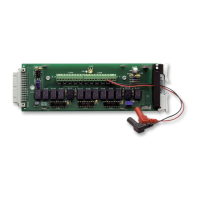3: Functions and features Model 2450 Interactive SourceMeter® Instrument
3-122 2450-901-01 Rev. B/September 2013
From the front panel:
1. Power on all instruments connected to the TSP-Link network.
2. Press the MENU key.
3. Under System, select Communication. The SYSTEM COMMUNICATION window opens.
4. Select the TSP-Link tab.
5. Select Initialize.
Using TSP commands:
To initialize the TSP-Link system, send the command:
tsplink.initialize()
To check the state of the TSP-Link system, send the command:
print(tsplink.state)
If initialization was successful, online is returned. If initialization was not successful, offline is
returned.
Sending commands to TSP-Link nodes
You can send remote commands to any instrument on the TSP-Link system by adding node[N]. to
the beginning of the remote command, where N is the node number.
For example, to sound the beeper on node 10, you would send the command:
node[10].beeper.beep(2, 2400)
To send a command to the master, you can use the global variable localnode as an alias for the
node entry. For example, if a script is running on node 5 (which would make node 5 the master), you
can use localnode as an alias for node[5]. In this example, to access the product model number,
you would send:
print(localnode.model)
Using the reset() command
Most TSP-Link
®
system operations target a single node in the system, but the reset() command
affects the system as a whole by resetting all nodes to their default settings:
-- Reset all nodes in a TSP-Link system to their default state.
reset()
Using the reset() command in a TSP-Link network differs from using the tsplink.reset() or
tsplink.initialize() command. The tsplink.reset() or tsplink.initialize()
command reinitializes the TSP-Link network and may change the state of individual nodes in the
system.

